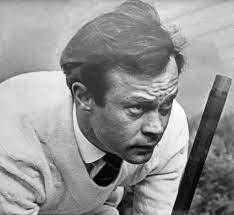HALL OF
Fame
JOHN SOLOMON

Inducted into the Croquet Hall of Fame in 2019, John emerged onto the English tournament croquet scene in 1948 at a time when croquet appeared to be doomed. Only 16, his youth and exceptional ability did much to keep croquet alive. He made remarkable progress and, within 2 years, he played in and won the New Zealand Open Championship and Double Championship.
FULL BIO
John Solomon was inducted into the venerable World Croquet Federation Hall of Fame in 2006 for his extraordinary contributions to the sport internationally, but he was never inducted into the US Croquet Hall of Fame, despite his major impact on the sport in this country…until now. His activities in support of croquet in the US epitomize the qualities we seek in a United States Croquet Hall of Fame member. Solomon was an outstanding teacher and ambassador for croquet with a lifetime of croquet achievements and the highest regard for the spirit and etiquette of the game. He is the first international player to be so honored.
Born in Wandsworth, South London, John Solomon emerged onto the English tournament croquet scene at age 16 in 1948, just after World War II, when croquet could be said to be hanging by a thread. An entry from the WCF website notes, “Affected by the loss of many clubs and about half of the Croquet Association’s members, it seemed to be a game almost exclusively for old people and doomed to fizzle out in the next decade or so. Fortunately for croquet, John appeared and, aided by youth and exceptional ability, did much to keep the flame alive for many years.”
Making rapid progress in his first two seasons of Association Rules tournaments, he was invited to join the English team for the 1950/51 Test series in New Zealand. Although he was only 18 at the time and had never played in a championship or won a major event, Solomon played extremely well in the Test Matches and went on to win the New Zealand Open Championship and Doubles Championship for good measure.
He returned home to begin a croquet career that dominated the English game throughout the 1950s and 60s. He amassed 10 Open Championships, 10 Men’s Championships, 10 Doubles Championships, nine President’s Cups, four Champion of Champions victories, a mixed Doubles Championship and two New Zealand Open and Doubles Championships, a total of 48 championship titles! It was an extraordinary tally, which remained unequalled until 2012. Even the way he held his mallet is known respectfully as the “Solomon Grip,” and used enthusiastically by many top players today.
Solomon also represented England in the MacRobertson Shield on five occasions from 1950-1974. However, it is not for just his many successes that croquet players are indebted to him. Instead, what mattered more was the way he achieved his success and how he was willing to use his legendary status of success to promote the sport.
John Solomon’s special talent was to make croquet look easy, rhythmic and elegant. Although croquet was thought of as a game suitable for the elderly, with Solomon on the court it was obvious that it was also a game of great skill and precision and one for all ages. Not content just to reel off the victories, he particularly enjoyed pushing the boundaries by trying new openings and tactics, such as the triple-ball triple and the jump over rover to hit the peg.
John Prince, another international croquet legend who met Solomon in New Zealand in 1963, says “the Solomon effect was to give the spectator the impression that they were watching a virtuoso playing a favorite piece of music, and that John was to croquet what Roger Federer is to tennis, particularly in his demeanor on court and sportsmanship. He was simply the consummate sportsman.”
To give something back to the game, Solomon directed his efforts into croquet administration and promotion. At age 30, he became Chairman of Council, and later served as President of the Croquet Association for 22 years. His legendary status drew many invitations from outside the UK. His visits to croquet clubs on several continents were greatly appreciated and played an important part in assisting and encouraging the birth of organized croquet.
In 1967, he met the late Jack Osborn, founder of the US Croquet Association. At Osborn’s invitation, Solomon brought a Hurlingham team to Westhampton Beach, N.Y., to play the Westhampton Mallet Club.
Osborn later expressly acknowledges the impact of Solomon’s strong advice regarding the important first step in establishing a national croquet body, to “develop a single, agreed upon set of rules.” From that flowed the formation of the USCA, the involvement of American players in international croquet, the first Test between the US and Great Britain at Nottingham in 1985, the establishment in 1988 of the Solomon Trophy for annual competition between Great Britain and the US, and the admission of the US to the MacRobertson Shield in 1993. As the senior international croquet statesman, Solomon made many truly great contributions to the world of croquet, which fully complemented his illustrious playing.
Solomon’s legacy is a game established in almost 30 countries throughout the world and a succession of champions who have followed in his footsteps over the last 50 years. Nigel Aspinall, Keith Wylie, Robert Fulford, Reg Bamford and Robert Fletcher are the names that spring immediately to mind. However, it is very uncertain where they might have been in the game of croquet and whether any of them would have become players and champions had the young John Solomon not taken up the game almost 70 years ago and played it with such expertise and style. He is a welcome new member of the US Croquet Hall of Fame.


